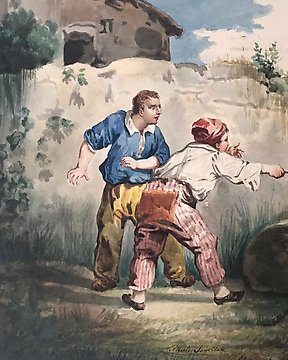
Alberto Sanvitale (XIX) - Due bambini che giocano con cannoncino
Nr. 81425577

Nr. 81425577

This exquisite set of prints depicts the solar system from the view of the Holy Scriptures (plates 7, 9) and the opposing —printed on (plates 1, 3 & 6). The Muggletonians were a small English religious sect that objected to "modern" science, particularly heliocentric astronomy and Newtonian physics.
Founded in the 1650s by two cousins who received "messages from God" that they were God's chosen witnesses prophesized in the Book of Revelations to preach to the ungodly world in its final days, the sect lasted well into the Victorian era. Isaac Frost, a scientist and prominent sect member, was instrumental in refining the Muggletonian's geocentric astronomical theory. The plates, first issued under the title Two Systems of Astronomy, illustrate "The Newtonian System of the Universe" and "The System According to the Holy Scripture" The text captions on plates six, reads ", This diagram will show that if the Earth revolves around the Sun, as the Solar System states, then it will necessarily follow, that the Earth will differ in its position with the Sun and any given fixed star on its equator, every day throughout the whole year. Now consider it is so. If not, it will make much in favour of the Holy Scriptures, that the Sun revolves round the Earth."
Frost’s book presents the central Muggletonian belief, based on scripture, in a physical heaven and stationary earth, against which the Newtonian heliocentric universe and plurality of worlds were fundamentally opposed. The book’s structure and images were divided between these two opposed world systems. The plates thus represent the Newtonian universe full and endless, with no room for God and nothing special about humanity, compared to a Muggletonian universe with a physical heaven and space for God. Frost’s publication and images have been seen as a concerted response to the prevalence of Newtonian astronomical lecturers in the nineteenth century and a significant artisan response to ‘science from above’. Frost himself also took to lecturing on the Muggletonian universe, seeking to warn his fellows that Newtonian science was not compatible with the scriptures and would lead to their damnation. These prints are likely based on Frost’s diagrams produced to illustrate his lectures.
Isaac Frost, a scientist and author (with his brother) of The Works of J. Reeve and L. Muggleton (1832), was a practising Muggletonian, the religious sect founded in the aftermath of the English Civil War by two cousins who claimed themselves to be the "two witnesses" mentioned in the Book of Revelations.
As well as their unusual scientific content, the prints represent a unique print-making technique invented by the printer, George Baxter and patented in 1835. Frost chose to employ Baxter to make his book more visually compelling and impressive. Baxter’s was the first commercially successful method of colour printing, combining traditional ‘intaglio’ print engraving with up to twenty engraved wooden blocks each printed with a different colour. The method created cheap, good quality images that could be produced in large numbers, and was used by various printers until the 1870s. It was both laborious and complicated, however, and, combined with the rise of photography, ultimately resulted in Baxter’s financial ruin.
These prints are acquired from a family an inheritance, very sought after with a comparative set sold at 2015 at Christie's for over £5000.
Condition: Good.
Sold unframed
Moderate foxing around margins, with spots on plates 1, 6 and 7. Overall, the prints are in good condition.
Please check the photos to see the condition of all the plates.
So kaufen Sie auf Catawiki
1. Etwas Besonderes entdecken
2. Höchstgebot abgeben
3. Sichere Zahlung durchführen